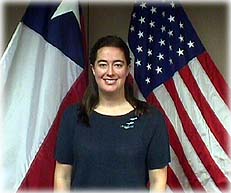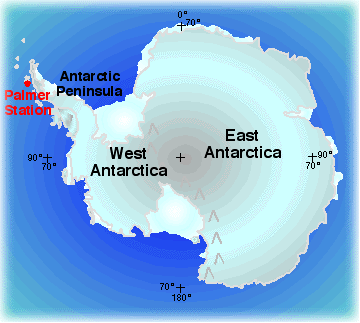





Hi! I'm Joanna Hubbard and I will be SCUBA diving from Palmer
Station during the austral summer of 1999-2000 with a team of scientists
including Drs. Amsler, McClintock, and Baker. I teach 7th grade science at
Hanshew Middle School in Anchorage, Alaska. Our school has approximately
850 students in 7th and 8th grades. We team teach, with 90-120 students
sharing the same 4-5 core subject (Math, Science, Social Studies, Language
Arts) teachers for the whole year. I also help coach Girls Volleyball and
Basketball for our school.
I graduated from Dartmouth College with a degree in Environmental Biology as
well as in Studio Art. I have previously worked in a molecular
genetics lab and in various field stations in Costa Rica and Jamaica.
I have a wide range of interests, but anything science related,
especially if it is outdoors, is fascinating. I help band migratory birds
in Alaska and enjoy birdwatching anywhere. Playing basketball and ultimate
frisbee as well as river rafting, hiking, biathlon, and competing in
orienteering meets with my family take up any free time I have. Sometimes
I manage to spend some quiet time painting, drawing or playing my flute,
but not very frequently. I am a compulsive reader and chocoholic. I love
to travel and see new places, both in and out of the U.S. Most recently I
have visited Malawi and Tanzania in Africa, and Yosemite National
Park in the United States. All beautiful! I can't wait to see the
wildlife on the Antarctic Penninsula. Please e-mail or visit this site
again to read my journal entries and find out what I am doing in
Antarctica. I will be in the field during March and April of 2000.

Location of Palmer Station on the Antarctic Peninsula

Palmer Station, Antarctica. Photograph by S. Shipp, Rice University.

The Chemical Ecology of Shallow-water Marine Algae and Invertebrates on the Antarctic Peninsula
Dr. Chuck Amsler, Department of Biology, University of Alabama at Birmingham
During March and April, the research team members will SCUBA dive in a
several kilometer radius around Palmer Station to collect specimens, use
the Palmer Station aquarium to stock invertebrates and macroalgae, and work
in the laboratory to analyze compounds from the specimens. The team members
will travel via Zodiac (a small inflatable motorboat) for dives. Frozen and
preserved samples of benthic invertebrates will be returned to the U.S. for
further studies. This project is an extension of work conducted on
the chemical ecology of marine organisms in McMurdo Sound, Antarctica. The
investigators identified secondary metabolites and looked at their
ecological role in a wide variety of sessile and sluggish antarctic marine
invertebrates. In the present project they are focusing on three questions
concerning the evolution of chemical defenses. They relate to the costs and
benefits of producing defensive secondary metabolites. The marine
environment of the Antarctic Peninsula is uniquely suited for these
studies.
a) It is an area of abundant macroalgal flora in a distinctive nutrient
environment that will allow the investigators to separate effects of carbon
and nitrogen limitation. They will test the hypotheses that macroalgae
growing with limited carbon (light) will produce higher levels of defensive
compounds than those growing in an optimal light environment and that
chemical defenses in antarctic macroalgae will include nitrogen-containing
compounds.
b) Invertebrate larvae are more accessible at Palmer Station than at
McMurdo Station. This will allow the investigators to build on previous
studies to answer more specific questions, such as: Are chemical defenses
in antarctic invertebrates and macroalgae more abundant in tissues which
contain a high energy content? Will invertebrate larvae be chemically
defended? and Will lecithotrophic larvae, which have more parental
investment per-larva, have better chemical defense than planktotrophic
larvae?
c) Previous work from the Ross Sea can be used to make large scale
comparisons. The investigators will use it and the information from
peninsular organisms to look for differences in macroalgal chemical defense
between taxonomic groups and biogeographic areas. They are parcticularly
interested in learning which factors affecting different macroalgal
populations have the greatest effect on the extent to which certain
compounds contribute to the chemical defence of the organism.








